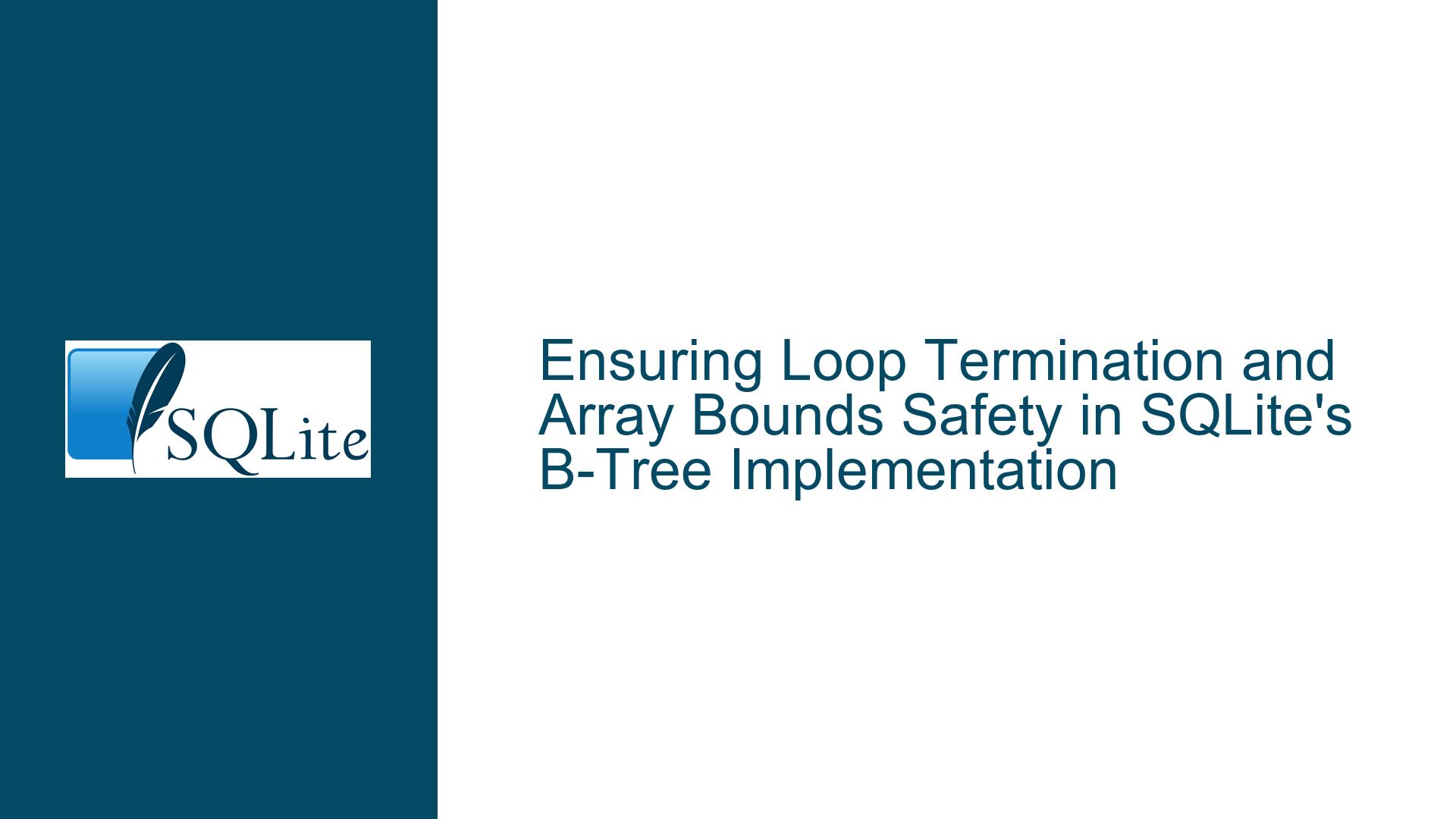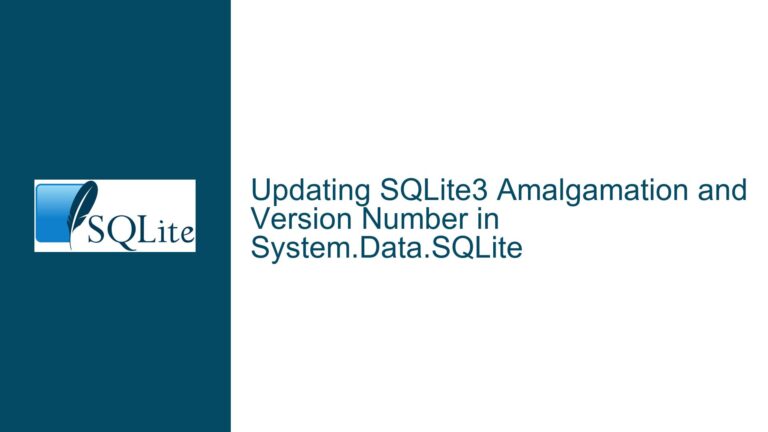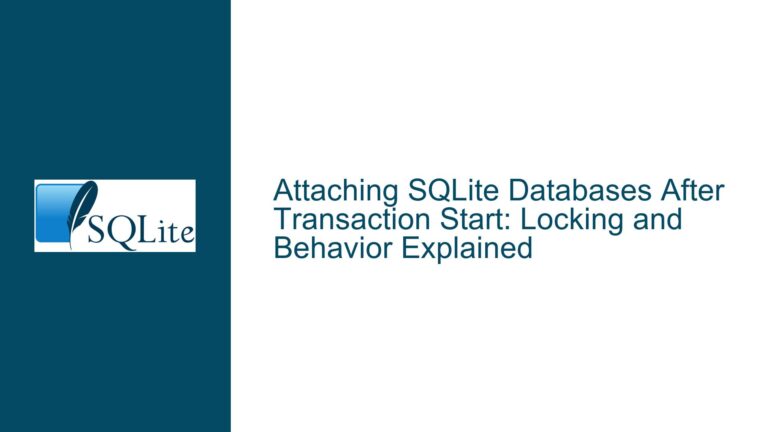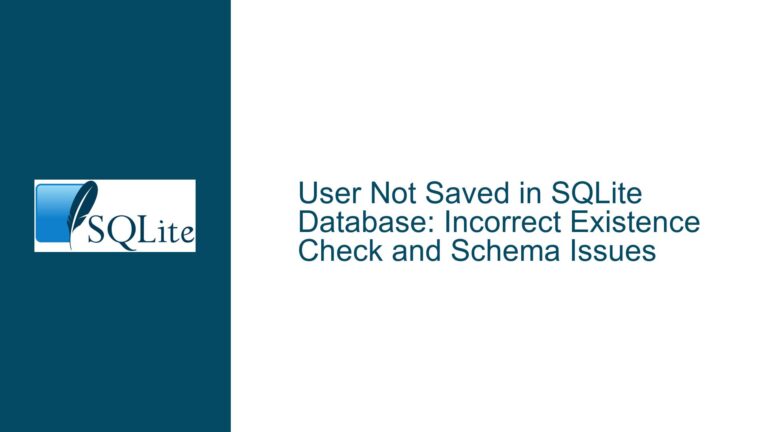Ensuring Loop Termination and Array Bounds Safety in SQLite’s B-Tree Implementation
Understanding the Role of ALWAYS() Macros in Loop Conditions and Subsequent Array Accesses
Issue Overview: ALWAYS() Macros in Loop Termination and Potential Array Overflow Risks
The core issue revolves around the use of the ALWAYS() macro in loop termination conditions within SQLite’s B-tree module (btree.c). These loops are designed to iterate over arrays of fixed size (typically NB*2, where NB is 3, resulting in a size of 6). For example, loops such as:
for(k=0; ALWAYS(k<NB*2) && pCArray->ixNx[k]<=i; k++){}
are followed by array accesses like pCArray->apEnd[k]. The concern arises from the possibility that k might increment to NB*2 (i.e., 6), leading to out-of-bounds array accesses.
The ALWAYS() macro is a defensive programming construct in SQLite. It asserts that a condition should always evaluate to true, even though the condition is not strictly necessary for correctness under normal circumstances. In debug builds, ALWAYS(X) expands to an assertion that X is true, while in release builds, it simplifies to X itself. The confusion stems from whether the ALWAYS(k<NB*2) check sufficiently prevents k from reaching NB*2, given that k is incremented after the loop condition is evaluated.
The risk identified is that if the loop exits due to pCArray->ixNx[k]<=i being false while k is still less than NB*2, subsequent accesses to apEnd[k] or ixNx[k] would use the final value of k, which could theoretically equal NB*2. This would result in accessing the 7th element of a 6-element array, causing undefined behavior.
Possible Causes: Misinterpretation of Loop Termination Logic and ALWAYS() Semantics
Loop Termination Mechanics in C:
In C, aforloop evaluates its condition before each iteration. The loop:for(k=0; ALWAYS(k<6) && pCArray->ixNx[k]<=i; k++){}increments
kafter the loop body (which is empty in these cases). The conditionALWAYS(k<6) && pCArray->ixNx[k]<=iis checked at the start of each iteration. If either subcondition fails, the loop exits. Crucially,kis incremented only if the condition holds at the start of the iteration.However, if
pCArray->ixNx[k]<=iremains true even whenk=6, theALWAYS(k<6)subcondition would fail, terminating the loop. In release builds, this is equivalent tok<6, which would evaluate to false, exiting the loop. Thus,kwould be 6 after the loop, leading to an out-of-bounds access.ALWAYS() Macro Behavior Across Build Configurations:
TheALWAYS()macro behaves differently depending on SQLite’s build settings:- Debug Builds:
ALWAYS(X)includes an assertion (assert(X)), causing a crash ifXis false. - Release Builds:
ALWAYS(X)compiles toX, relying on the program’s logic to ensure correctness. - Auxiliary Safety Checks Disabled:
ALWAYS(X)is hard-coded to1, removing runtime checks.
The static analysis warning arises because the analyzer cannot guarantee that
knever reaches6in release builds where assertions are disabled. This creates a false positive if the analyzer assumes the loop might exit withk=6.- Debug Builds:
Data Structure Invariants:
The loops in question are part of SQLite’s B-tree cursor maintenance logic. The arraysapEndandixNxare designed such thatixNx[k]is monotonically increasing. The loop exits whenixNx[k] > i, which should occur beforekreachesNB*2. This is an implicit invariant of the data structure, but static analyzers cannot easily infer this without additional annotations.Static Analyzer Limitations:
Static analysis tools lack runtime context and may fail to recognize that the loop terminates due toixNx[k] > ibeforekexceeds valid bounds. They conservatively assume thatkcould reach6, triggering a false warning about array overflows.
Troubleshooting Steps, Solutions & Fixes: Validating Loop Safety and Addressing Analyzer Warnings
Verify Loop Termination Logic:
- Step 1: Confirm that
ixNxis populated such thatixNx[k]values are sorted and bounded. For example, ifixNx[5]is the last valid entry, the loop must exit whenk=5(ifixNx[5] > i) or earlier. - Step 2: Add logging or debug assertions to track the maximum value of
kobserved during loop execution. This empirically verifies whetherkever reaches6.
- Step 1: Confirm that
Analyze ALWAYS() Macro Impact:
- Step 1: Review the build configuration. In debug builds,
ALWAYS(k<6)includes an assertion, ensuring termination ifkreaches6. In release builds, the loop condition becomesk<6, which will exit whenk=6, but subsequent array accesses must be validated. - Step 2: Inspect the code following the loop. For example:
pSrcEnd = pCArray->apEnd[k];If
kcan legally be6here, this is a critical bug. However, SQLite’s developers assert thatALWAYS(k<6)ensuresknever reaches6, makingapEnd[k]safe.
- Step 1: Review the build configuration. In debug builds,
Enhance Static Analyzer Understanding:
- Step 1: Use SQLite’s
assert()additions (e.g.,assert(k<6);after the loop) to inform the analyzer thatkis within bounds. For example, check-in 857f6d530949221d adds such assertions. - Step 2: Configure the static analyzer to recognize SQLite’s invariants. For instance, Clang’s
__builtin_assume(k < 6);could hint the analyzer thatkis bounded.
- Step 1: Use SQLite’s
Review Defensive Coding Practices:
- Step 1: Replace
ALWAYS(k<6)withALWAYS(k<6-1)if the loop must ensurekstays below6after incrementing. However, this is unnecessary if data structure invariants guarantee termination atk<6. - Step 2: Consider adding redundancy, such as:
assert(k < 6); pSrcEnd = pCArray->apEnd[k];This provides both runtime safety and analyzer guidance.
- Step 1: Replace
Addressing False Positives in Static Analysis:
- Step 1: Suppress specific warnings using analyzer directives (e.g.,
// NOLINTfor Clang-Tidy). - Step 2: Submit false-positive reports to the analyzer’s maintainers, including SQLite’s data structure invariants as evidence.
- Step 1: Suppress specific warnings using analyzer directives (e.g.,
Long-Term Code Resilience:
- Step 1: Refactor loops to use explicit bounds:
for(k=0; k<NB*2; k++){ if( pCArray->ixNx[k] > i ) break; }This separates the bounds check from the data-dependent condition, making the logic clearer to analyzers.
- Step 2: Adopt compile-time bounds checks using static analyzers integrated into SQLite’s CI pipeline.
- Step 1: Refactor loops to use explicit bounds:
By systematically validating loop invariants, leveraging assertions, and enhancing analyzer compatibility, developers can resolve the false-positive warnings while maintaining SQLite’s robustness against unexpected edge cases.
This guide provides a comprehensive approach to diagnosing and resolving loop termination and array bounds issues in SQLite’s B-tree implementation, emphasizing the interplay between defensive macros, static analysis, and data structure invariants.






